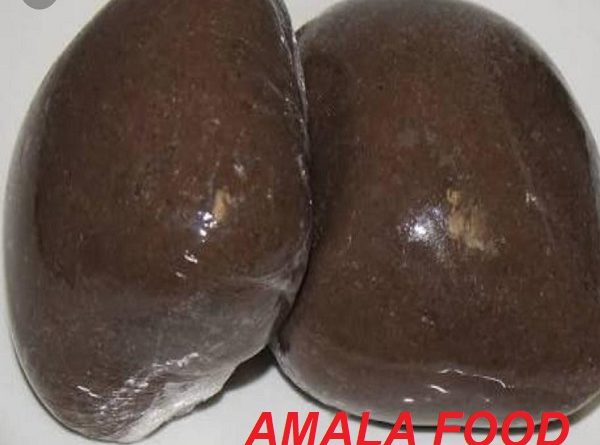Amala Food: How to Prepare Amala (Dark Brown Yam Flour)
Amala food is one of the most searched Yoruba dishes on Facebook and a common swallow in Nigeria.
Most Nigerians love eating this lightweight morsel also called Oka. The good news is that it can be eaten at any time of the day.

Amala Nigerian food is mainly eaten by everybody, crisscrossing its way through different tribes, borders and it has gained national status.
Initially, the color puts me off, but once I overcame that, I discovered that this West African food is helele (good). Nowadays, i eat amala food every other day especially now i know where they sell it near me!
It’s like discovering a new world of food delicacy. No food can be likened to it because it is so unique. There is no English name for Amala yet.
What is Amala Food?
It is a Nigerian food made out of yam flour and/or cassava flour. It is typically eaten by the Yoruba people of Nigeria.
Amala food products include yam which is peeled, sliced, dried and then grated or ground into a fine Amala powder known as Elubo. The preparation is different from Amala Lafun also known as White Amala.
Ever wondered why it is dark brown, Oka derives its color from yam when it turns brown after drying it.
This process is similar for plantain amala, although unripe plantains are used for that process.
Àmàlà and diabetes work hand in hand, especially when missed with plantain flour.
Table of Contents
Health Benefits of Amala Food- What does Amala do to the body?
The food (Elubo with ewedu and stew) is a very good meal for diabetic management because elubo (Yam flour) is known for its small glycemic index.
The dietary fiber in Elubo (Yam flour) aids to reduce low-density lipoproteins and the pepper used in making the stew stops the build-up of cholesterol in the body
Also, some antioxidants found in ewedu aids in lowering cancer risk. Besides, Dietary Fiber in elubo can reduce the risk of having colon cancer.
This happens by stopping the hazardous compounds in the food from affecting the colon mucosa.
Taking a healthy amount of Elubo (yam flour) with ewedu and stew is good for weight loss.
Pepper has a chemical compound called capsaicin that could speed up metabolism, keep immature fat cells from forming and so promotes weight loss.
It contains a lot of calories and is indeed a medical prescription for some folks; who cannot do without a dose of Elubo daily.
It is like a breach of their fundamental human rights to deprive them of this delicacy.
Àmàlà places near us continue to triple every day, with wide tentacles reaching many cities in the country.
Food lovers know the directory of cool spots where this African food is sold with Abula.
Amala Food Calories
Amala flour has many nutritional values:
- It is rich in iron and carbohydrate with less cholesterol, unlike Eba food.
- Amala is known for its low glycemic index which is good for diabetes patients.
- It improves cardiovascular diseases and the fiber in Amala helps reduce low-density lipoproteins.
- It has higher water content than most of the other swallow foods.
- This means less Cholesterol, less starch. It is a better choice compares to the rest swallow foods.
Nigerian Amala is relatively difficult to make. It requires practice and technique.
Nothing kills the swag of any amala faster than when there are lumps in tiny clusters all over the food.
However, when wielded with precision and just the right amount of muscle contraction, the amala comes out soft and evenly textured.
Amala Food Recipe
The only ingredient needed when making this food is boiling water and either one of the two types of flour: yam flour and/or cassava flour.
4 Easy Steps on How to Make Àmàlà Flour without Lumps
Here are the 4 simple steps to making a lump-free amala:
- First, heat water on the fire and allow boiling.
- After that, bring it down from the fire and gradually add your Abebi Yam Flour. Do not add the yam flour to the water while still on the fire so it doesn’t form lumps.
- Then, turn the yam flour with a wooden Eba stick (omorogun) quickly so as not to form lumps.
- Turn for a while, add little water and put it back on the fire to cook on low heat for about 5 minutes.
- Finally, after 5 minutes, begin to turn the Àmàlà again, keep turning until a smooth paste is formed. The pulling of the dough into a smooth paste is the most difficult part of making Elubo.
Àmàlà can be eaten with various types of soups, which include:
- Okro soup
- Efo riro: this is made from vegetables and a mixture of meat, fish, etc.
- Ogbono Soup:
- Gbegiri soup: this is made from dried beans.
- Egusi Soup:
- Amala and Ewedu: this is made from cooked and grated corchorus olitorius leaves with/without a small number of locust beans.
Health Risk
The sight is not appealing or inviting to some people. Apart from that, there have been concerns with the preparation of Amala food in some cases.
Some claim Amala flour is not processed hygienically because of the method used in drying it.
It’s from the back of the yam and can get mixed up accidentally with bird droppings, sand, etc during sun drying.
Amala Food Swallow: Health Benefits
Amala is a traditional Nigerian food made from yam flour. While it’s a staple dish in Nigeria, it’s not commonly known outside of West Africa. Here are some potential health benefits of Amala:
Good Source of Carbohydrates
Amala is primarily made from yam flour, which is rich in carbohydrates. Carbohydrates are the body’s primary source of energy, providing fuel for various bodily functions and physical activities.
Dietary Fiber
Yam flour used in making Amala contains dietary fiber, which aids in digestion, promotes bowel regularity, and helps prevent constipation.
A diet high in fiber is associated with a lower risk of various digestive disorders and may contribute to overall gut health.
Vitamins and Minerals
Yam, the main ingredient in Amala, is rich in various vitamins and minerals, including vitamin C, vitamin B6, potassium, manganese, and dietary antioxidants. These nutrients play essential roles in maintaining overall health, supporting immune function, and reducing the risk of chronic diseases.
Gluten-Free
Like many traditional African dishes, amala is naturally gluten-free, making it suitable for individuals with celiac disease or gluten intolerance.
Satiety
The combination of carbohydrates and dietary fiber in Amala can contribute to a feeling of fullness and satiety, which may help control appetite and support weight management when consumed as part of a balanced diet.
Low in Fat
Amala itself is low in fat, which can be beneficial for those aiming to reduce their fat intake or manage their weight.
Cultural Significance
While not a direct health benefit, the cultural significance of Amala should also be acknowledged.
Traditional foods like amala often hold cultural and social importance, promoting a sense of community and connection to cultural heritage.
It’s worth noting that the health benefits of amala can vary depending on factors such as portion size, cooking methods, and the ingredients used in accompanying soups or stews.
As with any food, enjoying amala as part of a balanced diet alongside a variety of other nutrient-rich foods is key to reaping its potential health benefits.



Pingback: Hibiscus Drink Recipe: How to Make Nigerian Zobo Drink
Pingback: Beans Soup: Nigerian Gbegiri Soup Recipe - 9jafoods
Pingback: Ibaba Soup: How to Cook Ofe Ukpo or Abachi - 9jafoods
Pingback: Nigerians and Our Swallow: 7 popular Nigerian swallows - 9jafoods
Pingback: Amala Nigerian Swallow Recipe - 9jafoods